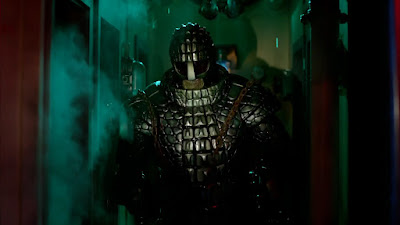A fairly straightforward one this - one of the most derivative Doctor Who stories ever. Not that Mr Gatiss hid the fact - he mentioned everything in interviews at the time.
Not only do a number of movies inspire Cold War, but earlier Doctor Who stories as well - primarily Troughton era ones.
Once one of the "Big Three" monsters, it looked for a time like the Ice Warriors were never going to make it into the new series. Steven Moffat himself was not impressed by them, regarding them as lumbering green giants which were difficult to make threatening to modern audiences. he worried that there might be little you could do with them that was original - and this story would have done nothing to change his mind on that score.
It was only at the insistence of Gatiss that Moffat agreed to bring them back. They are revamped, design-wise, but only slightly. Instead, Gatiss opts to look more at their background, inspired no doubt by their inclusion in a number of spin-offs (DWM comic strip and New Adventures novels especially).
One issue of contention is Gatiss' decision to show that the Ice Warriors are actually just wearing armour - as this was the opposite of what their designer, Martin Baugh, intended, and he ought to know. As a Grand Marshal, Skaldak really ought to have looked like the so-called "Ice Lords" seen between The Seeds of Death and The Monster of Peladon. We saw an actual Grand Marshal in the first of those stories, played by Graham Leaman.
The idea that they are skinny beings with claws that fail to match their pincer-like hands and with poorly rendered CGI faces is a great disappointment...
The starting point for Cold War is their very first story - The Ice Warriors. It took the whole of its first episode for the Martian to wake up but here, in the rushed 45 minute format, we learn that the creature has been found entombed in the ice in the Arctic and it is up and about before the opening credits have rolled.
Varga had also been found entombed in ice for many centuries, and was found by a group tasked with something else but which included a scientist with a secondary interest. Varga was found by an scientist with an archaeological background - Arden - when setting up seismic detectors, whilst Skaldak is found by the Russian military on an oil-seeking expedition, but which includes a civilian scientist - Grisenko.
Both Varga and Skaldak are awakened prematurely, and are at first thought to be of ancient terrestrial origins.
In both cases, the Ice Warrior finds themselves cut adrift from their own time and so desperately seeks to exploit their new-found situation to their advantage to get back in touch with their own kind.
Their actions escalate to threaten the whole Earth - Varga by wrecking the ionisation programme and Skaldak by triggering nuclear war - which brings us to the story title.
The Cold War is the period which lasted from the fall of Berlin in May 1945 through to Glasnost and Perestroika in the late 1980's - symbolised by the fall of the Berlin Wall in November 1989. The period was defined by war by proxy, with a number of global conflicts behind which lay the US and USSR, though they never dirtied their own hands publicly.
If a conflict with actual fighting was a "hot war", then one played out through "diplomacy" and string-pulling was therefore a "cold" one.
Gatiss elected to set his story during the 1980's, when the Cold War was hotting up again thanks to the sabre-rattling of Ronald Reagan and Mrs Thatcher, coinciding with a series of short-lived hawks in charge at the Kremlin.
This '80's setting is reinforced by Grishenko's love of music of the period - Duran Duran and Ultravox being specifically referenced.
The other big inspiration for Cold War is the submarine genre (sub-genre, anyone?). Gatiss specifically mentioned films like The Hunt for Red October (1990) which is set in the same period. Other sub-based films of recent years include Crimson Tide (1995), or the earlier Gray Lady Down (1978). Bond's The World Is Not Enough (1999) and The Spy Who Loved Me (1977) feature submarines prominently. Gatiss also mentioned the splendid German miniseries Das Boot (1981). War films like The Enemy Below (1957) and Run Silent, Run Deep (1958) had inspired the classic Star Trek episode "Balance of Terror", which first introduced the Romulans.
The submarine we see here is no CGI construct. It's a good old-fashioned model courtesy of Mike Tucker's Model Unit. We last saw a model submarine in the show in The Sea Devils, and the filming techniques - all done in the dry - are virtually the same.
This is Clara's turn to ask why she can understand foreign languages - something which each new companion goes through these days. This had always been glossed over by the programme, until Sarah brought it up in The Masque of Mandragora. In Rose it was confirmed that it was a function of the TARDIS.
Another Troughton nod is the manner in which the Doctor is conveniently separated from the TARDIS. This is said to be the fault of the HADS, the Hostile Action Displacement System which we first heard about in The Krotons.
The Pertwee era Peladon stories are also referenced as the Doctor describes himself once being an Earth Ambassador, and when he tells Skaldak of his people's achievements in the future.
Next time: I won't get the order of stories mixed up... This time it really will be a ghost story / romance mash-up.

No comments:
Post a Comment